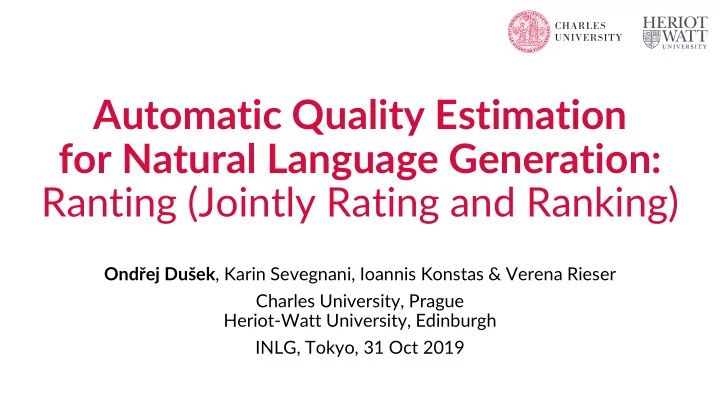

Automatic Quality Estimation for Natural Language Generation: Ranting (Jointly Rating and Ranking) Ondřej Dušek , Karin Sevegnani, Ioannis Konstas & Verena Rieser Charles University, Prague Heriot-Watt University, Edinburgh INLG, Tokyo, 31 Oct 2019
Our Task(s) • Quality estimation : checking NLG output quality • just given input MR & NLG system output • no human reference texts for the NLG output • supervised training from a few human-annotated instances • well-established for MT, not so much in data-to-text NLG • Rating : Given NLG output, check if it’s good or not (scale 1 -6) • Ranking : Given more NLG outputs, which one is the best? Rating: MR: inform_only_match(name='hotel drisco', area='pacific heights') 4 (on a 1-6 scale) NLG output: the only match i have for you is the hotel drisco in the pacific heights area. Rank: MR: inform(name='The Cricketers', eatType='coffee shop', rating=high, familyFriendly=yes, near='Café Sicilia') better NLG 1: The Cricketers is a children friendly coffee shop near Café Sicilia with a high customer rating . NLG 2: The Cricketers can be found near the Café Sicilia. Customers give this coffee shop a high rating. It's family friendly. worse
Why Quality Estimation? • BLEU et al. don’t work very well – can we be better? • evaluating via correlation with humans • We can do without human references – wider usage: • Evaluation, tuning (same as BLEU) • Tuning (same as BLEU) • Inference – improving running NLG systems • Inference time use: • for rating : don’t show outputs rated below a threshold • use a backoff or humans • ranking : select best system output from an n-best list Dušek, Sevegnani, Konstas & Rieser – Automatic Quality Estimation for NLG 3
Old Model (Dušek, Novikova & Rieser, 2017) • Ratings only • Dual-encoder • MR encoder • NLG output encoder • fully connected + linear • trained by squared error • Final score is rounded Dušek, Sevegnani, Konstas & Rieser – Automatic Quality Estimation for NLG 4
Our Model • Ranking extension: • 2 nd copy NLG output encoder + fully connected + linear • shared weights • trained by hinge rank loss • on difference from 2 ratings • Can learn ranking & rating jointly • training instances mixed & losses masked 5
Synthetic Data (Dušek, Novikova & Rieser, 2017) • Adding more training instances • introducing artificial errors restaurant • randomly:* • removing words name is a restaurant . • replacing words by random ones children • duplicating words • inserting random words price • For rating data: • lower the rating by 1 for each error (with 6 → 4) • This can be applied to NLG systems’ training data, too • assume 6 (maximum) as original instances’ rating * articles and punctuation are dispreferred Dušek, Sevegnani, Konstas & Rieser – Automatic Quality Estimation for NLG
Synthetic Ranking Pairs • Different #’s of errors introduced to the same NLG output • Fewer errors should rank better • Ranking pairs are useful when the system is trained to rate, too! restaurant 1 error Rank: X-name serves Chinese food . better 2 errors food cheaply worse X-name serves Chinese food . Dušek, Sevegnani, Konstas & Rieser – Automatic Quality Estimation for NLG 7
Results: Rating (Novikova et al., EMNLP 2017) • Small 1-6 Likert-scale data (2,460 instances) https://aclweb.org/anthology/D17-1238 • 3 systems, 3 datasets (hotels & restaurants) • 5-fold cross-validation System Pearson Spearman MAE RMSE • Much better correlations Constant - - 1.013 1.233 than BLEU et al. BLEU (needs human references) 0.074 0.061 2.264 2.731 Our previous (Dušek et al., 2017) 0.330 0.287 0.909 1.208 • despite not needing references Our base 0.253 0.252 0.917 1.221 • synthetic data help a lot + synthetic rating instances 0.332 0.308 0.924 1.241 • statistically significant + synthetic ranking instances 0.347 0.320 0.936 1.261 • correlation of 0.37 still not ideal + synthetic from systems’ training data 0.369 0.295 0.925 1.250 • noise in human data? • absolute differences (MAE/RMSE) not so great 8
Results: Ranking (Dušek et al., CS&L 59) https://arxiv.org/abs/1901.07931 • Using E2E human ranking data (quality) – 15,001 instances • 21 systems, 1 domain • 5-way ranking converted to pairwise, leaving out ties • 8:1:1 train-dev-test split, no MR overlap • Our system is much better than random in pairwise ranking accuracy System P@1/Acc • Synthetic ranking instances help Random 0.500 Our base 0.708 • +4% absolute, statistically significant + synthetic ranking instances 0.732 • Training on both datasets doesn’t help + synthetic from systems’ training data 0.740 • different text style, different systems Dušek, Sevegnani, Konstas & Rieser – Automatic Quality Estimation for NLG 9
Conclusions • Trained quality estimation can do much better than BLEU & co. • Pearson correlation with humans 0.37 vs. ~0.06-0.10 • synthetic ranking instances help • The results so far aren’t ideal (we want more than 0.37/74%) • Domain/system generalization is still a problem • Future work: • improving model • using pretrained LMs • obtaining “cleaner” user scores • more realistic synthetic errors • influence of error type on user ratings Dušek, Sevegnani, Konstas & Rieser – Automatic Quality Estimation for NLG 10
Thanks • Code & link to data + paper: http://bit.ly/ratpred • Contact me: odusek@ufal.mff.cuni.cz http://bit.ly/odusek @tuetschek Paper links: this paper: arXiv: 1910.04731 previous model: arXiv: 1708.01759 datasets used: ACL D17-1238, arXiv:1901.07931 Dušek, Sevegnani, Konstas & Rieser – Automatic Quality Estimation for NLG 11
Recommend
More recommend